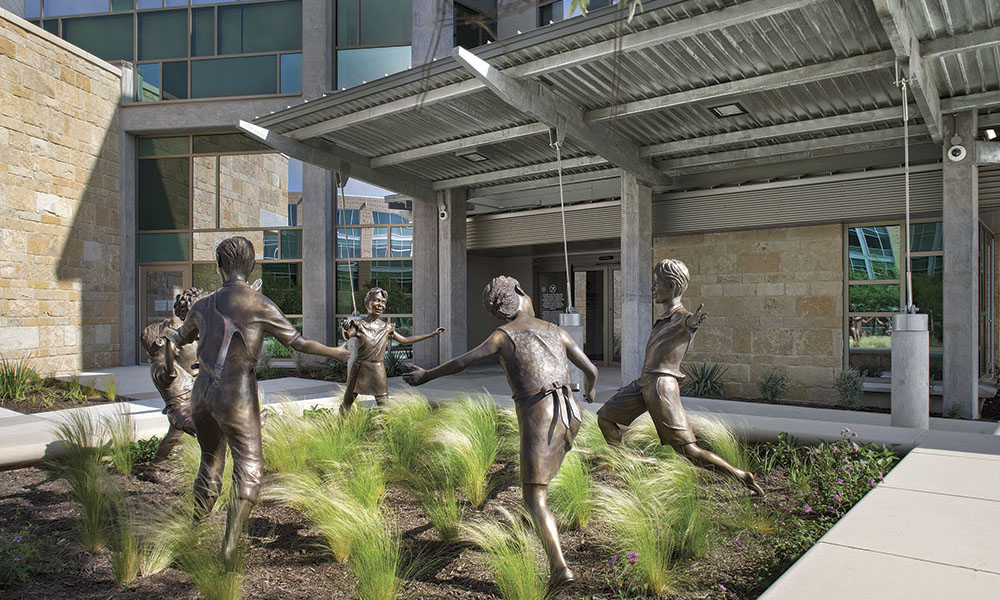With its new 72-bed addition, Dell Children’s Medical Center of Central Texas has achieved what no other hospital has: becoming the first to earn LEED Platinum certification twice — first for the original structure completed in 2008 and now being the first in the world to achieve LEED-HC Platinum for its 2013 expansion, the W.H. and Elaine McCarty South Tower.
With the recent introduction of LEED-HC, more forward-thinking facility owners like Dell are investigating the feasibility of sustainability.
Many owners are concerned the work and materials needed to meet LEED-HC requirements would add unwanted complexity and costs to a project. The generally held belief is that the cost to obtain Platinum status adds 10 percent or more to the project budget. Initial evaluation of the Dell project’s overall budget revealed the premium to achieve LEED-HC Platinum certification added surprisingly little to the overall project design-build cost: just 2.3 percent, significantly lower than the popular perception. This includes soft costs such as LEED consultation and U.S. Green Building Council fees, recycling premiums and documentation costs, as well as the hard costs for sustainable building materials, including a photovoltaic array.
In reality, sustainable healthcare facilities cost little more to build and less to operate and maintain than non-sustainable counterparts. Because most healthcare facility owners build the structure and operate it, it makes sense to weigh the design and construction costs against long-term operational costs. Most will find that the extra investment to build a sustainable facility will pay off in a big way over time.
Real-world strategies that work
Given that the premium to build a LEED-HC Platinum healthcare facility is relatively minor, the next consideration is how to do it. The USGBC is thorough in laying out the intent, requirements and recommended strategies on how to achieve LEED-HC credits but leaves it up to the owner and design and construction teams to select the best course of action. For many owners, this is where it gets confusing and even intimidating. It’s also where proven strategies gained from real-world projects are exceedingly useful. These strategies include:
Integrated Project Delivery
IPD is an integral part of LEED-HC certification. Getting the entire team collaborating on ideas early and often is critical to the project’s success, particularly when dealing with a brand new rating system and a lofty Platinum goal. Cost and timesaving ideas can be discussed before the building is designed, preventing the need for value engineering.
One important requirement for the IPD credit is writing a Health Mission Statement to ensure that everyone understands the hospital’s sustainability intent. While not a requirement, some LEED consultants also have the design team, general contractor and other key consultants sign a Responsibility Letter to ensure all are held responsible for respective credits and are as committed to the project’s success as the owner.
Healthy building materials
The USGBC is driving the market with new credits that encourage building material manufacturers to produce environmentally friendly, less harmful products. A new prerequisite, as well as new credits in the Materials and Resources category, address elimination of products with health-related risks.
Recently, a movement among architecture firms across the nation has emerged to encourage transparency among manufacturers to disclose product ingredients and provide verified lifecycle information to aid decision-making on building material specifications. Learn more at www.hpdcollaborative.org.
While the architectural designer specifies building products, it is just as important that the general contractor verify that what is purchased and installed in the building is free of banned substances. During the submittal process, a key driver to success is to require all subcontractors and suppliers to complete a form disclosing the makeup of products with verifiable manufacturer data.
The Dell project team pursued USGBC Pilot Credit 11, Chemical Avoidance in Building Materials, which eliminates the use of phthalates and Pilot Credit 2 PBT Source Reduction, which eliminates dioxins and halogenated organic compounds in building products. In some instances, performance and cost barriers prevented their use.
Prefabrication
Prefabrication can play a major role in reducing sustainable project costs. Extensive use of building information modeling enabled ease of prefabrication for patient room headwalls and restrooms for Dell Children’s South Tower. Benefits included significant improvements in project schedule, product quality and the elimination of waste, as well as a reduction in budgeted labor costs for that portion of the project by 54 percent.
Construction waste diversion
Keeping building scrap out of landfills is a major component of achieving sustainability goals. The Dell project team developed an aggressive construction waste diversion plan with a goal of diverting 95 percent of waste. To meet the facility’s requirement, a single-stream waste hauler was used to take material offsite to sort and weigh. More than 3,000 tons of waste — 96 percent — was diverted from the landfill.
Building envelope commissioning
As part of the enhanced commissioning credit, LEED-HC includes envelope commissioning to help owners earn extra points. Envelope commissioning ensures healthy indoor air quality, as well as optimizes infection control and energy performance.
To earn these credits, early design details are scrutinized and the envelope is subjected to performance testing using thermal imaging and water testing during construction to identify and alleviate potential problems. The cost of envelope commissioning is expected to have a relatively short payback because it directly lowers ongoing energy and maintenance costs.
Energy credits
High-performance strategies — LED lighting, high-efficiency glazing, building envelope commissioning and automated lighting and controls that respond to patient room occupancy — significantly reduce energy consumption in the Dell bed tower. These strategies, along with the help of an onsite natural gas-fired co-generation power plant operated by local power company Austin Energy, and a photovoltaic array, yielded an energy savings of 47.7 percent.
By utilizing proven, practical strategies at the earliest stages of the project to incorporate sustainable design, construction and waste management practices, owners can lower operational costs, improve staff retention and take pride in providing a healthier atmosphere for patients and employees, all with less impact to the environment.
Photos by Thomas McConnell





